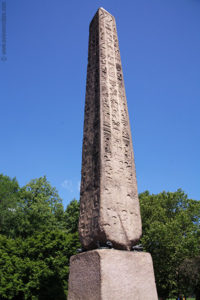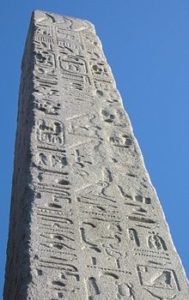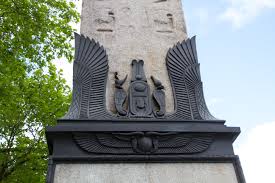
How old do you think the oldest structure in New York City is? Most people would guess something from the Dutch Colonial period – dating back to the 1650s or 1660s. That would make it no older than 360 years.
In truth, the oldest structure in New York City is roughly 3,460 years old. It’s a granite obelisk called Cleopatra’s Needle.
Maybe that’s cheating a bit, since the 69-foot artifact has really only been in the city since 1880. It stands today as a wonderful anomaly, anchored to the ground in the leafy environs of Central Park.
Cleopatra’s Needle is one of a pair commissioned by the pharaoh Thutmose III in about 1450 B.C. for the city of Heliopolis. In about 12 B.C., Augustus Caesar moved them both to the port of Alexandria where they were reinstalled in front of the monument that Cleopatra built to honor the “god” Julius Caesar. They’ve both taken their knocks over the years, enduring falls, erosion, water damage and acid rain. One of them ended up in London. The one that’s here, looks pretty good for its age. Its still-decipherable hieroglyphs pay tribute to two later pharaohs, Ramesses II and Osorkon I.
Now, as the Central Park Conservancy develops a plan to conserve it, the Metropolitan Museum – which has several nice views of the monument in its back yard – has mounted a show about its history and the symbolism of obelisks over the centuries.
There you can see a delicate limestone relief of Thutmose III, its finely carved edges as crisp as if it was just stamped out of clay. Thutmose faces a similar relief of Ramesses II. Despite the rigid stylization of features like the bound-up beard and the cobra headdress, their faces are individualized. Thutmose has a bigger nose, fuller lips and narrower eyes than Ramesses. Ramesses (1303 BC to 1213 BC), also called Ramesses the Great, is the most legendary of the pharaohs. He conquered many lands, fathered more than 100 children, and is said to be the inspiration for Shelley’s poem “Ozymandias.”

Obelisks come in all sizes, from the 550-foot Washington Monument in our capital down to a cute funerary pair from the Met’s own collection. These are less than two-feet tall, dating all the way back to the Old Kingdom – more than 4,000 years ago.
Transporting the 193-ton Cleopatra’s Needle from Alexandria and installing it on Greywacke Knoll in Central Park was a yearlong production, involving wooden support towers, cannonball rollers, a team of 32 horses and a special s railroad trestle that ran from the East River at 96th Street to the park. Even more amazing is that the ancient Egyptians were able to make and move it with nothing but human labor and ingenuity. Exhibit diagrams show how it was carved from a bed of solid granite, which involved tunneling under it, then raising to a vertical position using wedges and ropes, then floating down the Nile on a barge.
Obelisks caught on big in Western culture, first with the Romans, who built so many that Rome today has more obelisks than any other city in the world. Although the Egyptians saw them as cosmological connectors between sky and earth, the Romans liked them mostly as symbols of imperial power. They toppled when Rome fell and were excavated and re-erected about a thousand years later in the Renaissance. Pope Sixtus V, who put up four of them, liked them as symbols of papal authority.

In the 17th and 18th centuries, the fraternal order of the Freemasons readily adopted obelisks as one of many symbols in their Hermetic tradition, a mixture of ancient Egyptian, Greek and Christian beliefs. The exhibit also shows how obelisks became popular funerary monuments that evoked feelings of eternity.
The exhibit devotes little comment to the 20th century’s Freudian interpretation of obelisks as phallic symbols. But then, beyond mentioning it, what else is there to say on that subject?

